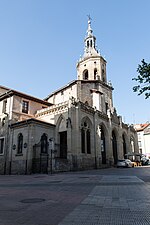Cathedral of María Inmaculada of Vitoria
Roman Catholic cathedrals in the Basque Country (autonomous community)

The Cathedral of María Inmaculada de Vitoria (Basque: Maria Sortzez Garbiaren katedrala, Spanish: Catedral de María Inmaculada de Vitoria, usually known as "The new Cathedral" (Basque: Katedral Berria, Spanish: Catedral Nueva) is a Neogothic-style, Roman Catholic cathedral located in Vitoria-Gasteiz, Basque country, Spain. It was built in the first half of the 20th century.
Excerpt from the Wikipedia article Cathedral of María Inmaculada of Vitoria (License: CC BY-SA 3.0, Authors, Images).Cathedral of María Inmaculada of Vitoria
Cadena y Eleta apezpikuaren kalea/Calle Monseñor Cadena y Eleta, Vitoria-Gasteiz Lovaina
Geographical coordinates (GPS) Address External links Nearby Places Show on map
Geographical coordinates (GPS)
| Latitude | Longitude |
|---|---|
| N 42.845403 ° | E -2.677563 ° |
Address
Catedral de María Inmaculada / Maria Sortzez Garbiaren katedrala
Cadena y Eleta apezpikuaren kalea/Calle Monseñor Cadena y Eleta
01008 Vitoria-Gasteiz, Lovaina
Autonomous Community of the Basque Country, Spain
Open on Google Maps











